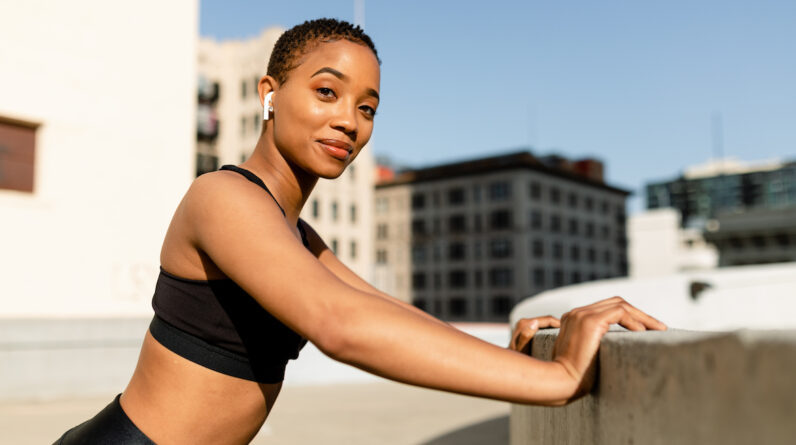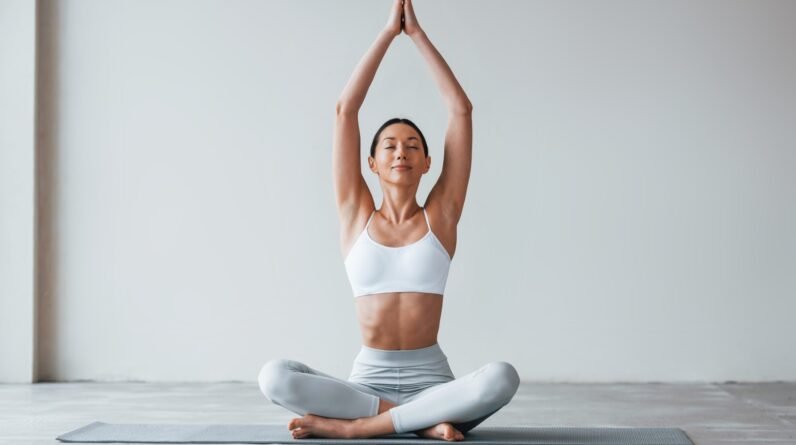
Sleep is now a sport, and after the first night using my Eight Sleep Pod Cover ($2,195) and waking up to a sleep score of 100, I felt like a gold medalist. Rested and ready to take on the world, I got up and cycled through bodyweight exercises, got my heart rate up on a run, and Theragunned my muscles, so I was ready for a day of sprinting ahead of me. Then, the twins in the room next to me began whining for their bottles, and I was swiftly ushered back to my reality: one where I am not an Olympic-medalling athlete but a stretched-thin mom who dabbles in fitness for fun.
Yet, as fitness trackers get better and better at deciphering information from our bodies and telling us how to use it, we don’t necessarily need to be Olympic-level athletes to understand how to optimize our days with movement. Certainly, athletes do this—swimmer Ryan Murphy, basketballer Chelsea Gray, and CrossFitter Any Bream all use Eight Sleep—but so, too, do everyday people looking to find ways to energize without that extra cup of coffee.
“Sleep is undoubtedly one of the most crucial factors for an athlete’s mental and physical health and performance,” says Alexandra Zatarain, co-founder and VP of brand and marketing at Eight Sleep. Whether you’re chugging along at the gym to feel better in your day-to-day life or winning medals, understanding the impact of what you’re doing when your head hits the pillow can help to inform how you show up in the gym and beyond.
What’s the Eight Sleep Pod Cover?
We’ve all become quite accustomed to using fitness trackers in our day-to-day lives—think Apple Watches, Oura Rings, and Fitbits. However, this tracker is different because you don’t wear it per se, but rather sleep on top of it. “The Pod helps athletes recover better by regulating their body temperature throughout the night,” says Zatarain. “This optimizes each stage of sleep and leads to enhanced deep sleep, REM sleep, and total sleep time, thus leading to improvements in sleep quality.”
It has a feature called “Autopilot” that raises and lowers the temperature of the bed—and thus, your body—to help you optimize whatever sleep stage you are in. It’s been clinically proven to increase deep sleep by 34 percent, which helps to impact how you recover and how you feel the next day. According to Zatarain, it does this by dropping your core body temperature in the earlier part of the night to promote deeper sleep, which is beneficial to those who like to work out in the later parts of the day. Working out can raise our core body temperature, which can cause us to have difficulty going to sleep and reduce the quality of deep sleep that we get.
The technology is driven through “invisible” sensors, which track your heart rate, heart rate variability, and respiratory rate. “From these variables, we can deliver real-time sleep staging,” says Zatarain. Or in other words, the mattress heats and cools you to keep you comfortable and cool, which independent research indicates translates to better sleep.
Then, when you wake up in the morning, it uses all of this data to give you a Sleep Fitness Score that can help to inform your day and how you approach it. The Fitness score is affected by the quality of sleep you get, how closely you follow your sleep routine (i.e. keep a bed and waking time), and the time you spend asleep (between seven and nine hours). It’s a numeric system that’s paired with directives like “Good, Fair, Pay Attention, etc.” so that you can understand how you’re sleeping.
How Sleep Impacts Your Workout
If your workout is your main form of effort, then sleep is your main source of recovery. “Sleep is key to repairing damaged tissue,” says Samantha Ward, NASM, CPT, Equinox Tier X Coach and EFTI Master Instructor. “Therefore, if you are not sleeping well, your body’s healing process is slowed, creating an increased risk for injuries.”
Research indicates that sleep helps to regenerate cells that help us to repair our bodily tissues and helps to bolster our immune systems, which keeps us from getting sick and allows us to stay on our feet. And that translates to us feeling better and being able to work out or do whatever else we want to on a given day.
While it’s easy to fall into the trap of thinking that one bad night’s sleep means that you might not be able to conquer your workout in the way you would like, Ward warns that’s not necessarily true. “Sleep is cumulative. We often look at it as something that is done once during each day rather than viewing it on a macro scale,” she says. “I say this because one bad night of sleep isn’t going to impact your ability to perform and recover as much as several poor nights of sleep.”
So while the Eight Sleep Pod Cover does provide you with nightly data, it’s a good idea not to fixate on one bad number and what it means for your day, but rather to take trends—several nights of poor quality sleep or elevated heart rate—to heart and adjust your lifestyle accordingly.
How To Hack Your Workouts With the Eight Sleep Pod Cover
When I tried the Eight Sleep Pod Cover, I wanted to use it to help my body gauge what it could take on each day. The first few days, my sleep scores were high: 100, 99, 97… you get the picture. Those days, I felt invincible and could lift and run as much as I felt like I needed to. Then came the first B- night, which on my feet, felt quite different than an A+, despite Ward’s advice. Couple this with the disturbed sleep that happens due to menstrual cycles and babies waking up in the middle of the night, and it’s easy to see how quickly you can fall from the heights of a 100-level sleep.
Based on your sleep quality, Ward advises tweaking the frequency and intensity of your workouts. On days when I was hitting A-level sleep efforts, I accepted the challenge to do higher-intensity bodyweight training, running, and even HIIT. But when my sleep scores fell below 85 for a few consistent days, I backed off. Instead, I opted for Pilates or a walk and threw a run into the mix only once during my downbeat.
While I truly expected to have a new tech-y sixth sense—the exercise sense—what I found is that our bodies sort of intuitively also know their limits and know what they need. On days when I was really tired and had a score in the 50s, I didn’t feel like a HIIT class. So, I’d either take the day off or do some light stretching. To put that another way, I was never surprised by a sleep fitness score or how that left me feeling about what kind of effort I could do in the gym.
Having used the Pod Cover for about a month for exercise monitoring, what I saw was an uptick in my vitals. My HRV went up (a good sign that your body is tolerating and recovering from stress); my respiratory rate and heart rate went down; and I became more aware of the importance of keeping a consistent sleep routine to stay optimally healthy. What’s more, the quality of my sleep largely continued to improve with the Eight Sleep. I found myself waking up and feeling much more rested and ready to take on the day than I had without it.
Other Considerations To Keep in Mind
Obviously, while our sleeping habits affect our waking hours, our habits while awake also affect our sleep. Given this, Ward has a few recommendations to help you create the best sleep possible.
1. Remember To Train at the Right Time of Day: “For some people, higher intensity workouts later in the day can impact their ability to get restful sleep,” she says. This happens because these workouts can raise your core body temperature, making it hard to fall asleep. Instead, opt for low-impact or recovery workouts later in the day.
2. Time Your Meals and Caffeine: When you eat and what you sip can impact how you train. We’ve previously reported that diets rich in complex carbohydrates, protein, and fruits and veggies can help you get some solid shut-eye.
3. Clean Up the Time Before You Sleep: Take stock of the time before you go to sleep. “Activities in this time frame should all be geared towards winding down the body and mind,” says Ward.
4. Start Your Day Off Energetically: “Start your day with activities that promote wakefulness- getting sunlight to your eyes [or] body, hydrating, and getting in some movement and activity are great ways to begin,” she says.
Final Thoughts
Ultimately, the Eight Sleep Pod Cover is some of the coolest tech that I’ve tried this year—and a lot comes across my desk. Used properly, it can help you recover so that you can tackle marathon meetings and marathons in the same stride. I heartily recommend it for those looking to approach their sleep as a sport.







